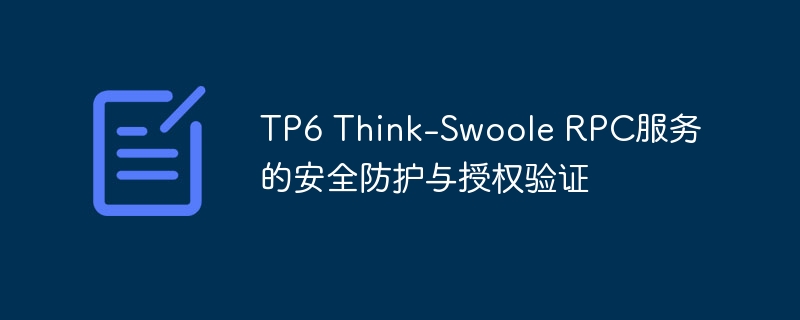

TP6 Think-Swoole RPC service security protection and authorization verification
With the rise of cloud computing and microservices, remote procedure call (RPC) has become a popular choice for developers an essential part of our daily work. When developing RPC services, security protection and authorization verification are very important to ensure that only legitimate requests can access and call the service. This article will introduce how to implement security protection and authorization verification of RPC services in the TP6 Think-Swoole framework.
1. Basic concepts and principles of RPC services
RPC (Remote Procedure Call) is a remote procedure call, which allows programs to communicate and call functions between different computers or processes. Usually, an RPC service includes a client and a server. The client sends a request, and the server performs corresponding operations according to the request and returns the result.
2. Think-Swoole framework and RPC service
Think-Swoole is a set of high-performance PHP framework developed based on Swoole extension. It provides a wealth of functions and components and is very suitable for development. High performance and distributed systems. Among them, Think-Swoole's RPC component can help us quickly build RPC services.
3. Security protection of RPC services
In order to prevent illegal access and malicious attacks, you can restrict it through IP whitelist Only IP addresses in the whitelist can access the RPC service. In the TP6 Think-Swoole framework, middleware can be added when the server starts to implement IP whitelist verification.
// 定义IP白名单 $ipWhiteList = [ '127.0.0.1', '192.168.1.100', ]; // 中间件验证IP白名单 Middleware::add(function ($request, $handler) use ($ipWhiteList) { $ip = $request->getRemoteAddress(); if (!in_array($ip, $ipWhiteList)) { // 非法IP,返回错误信息 return new Response('Forbidden', 403); } return $handler->handle($request); });
A replay attack refers to a situation where an attacker intercepts and repeatedly sends legitimate requests, causing the server to process the same request repeatedly. In order to prevent replay attacks, you can add a timestamp and a random number to the request, and the server verifies the validity of the timestamp and random number.
// 请求参数中加入时间戳和随机数 $requestData = [ 'timestamp' => time(), 'nonce' => mt_rand(), // 其他参数 ]; // 中间件验证时间戳和随机数 Middleware::add(function ($request, $handler) { $timestamp = $request->param('timestamp'); $nonce = $request->param('nonce'); // 验证时间戳和随机数的有效性 // ... return $handler->handle($request); });
In order to protect the security of the data, the request and response data can be encrypted. In the TP6 framework, we can use encryption algorithms such as AES to implement data encryption.
use think acadeCrypt; // 请求参数加密 $requestData = [ 'data' => Crypt::encrypt($requestData), ]; // 响应数据解密 $responseData = Crypt::decrypt($responseData);
4. Authorization verification of RPC services
In order to ensure that only authorized clients can call RPC services, authorization information can be added to the request and verified on the server side. In the TP6 Think-Swoole framework, middleware can be used to implement authorization verification.
The client can generate a unique authorization code and add the authorization code to the requested Header.
// 生成授权码 $authorization = 'Bearer ' . md5(uniqid()); // 将授权码加入Header中 $client->setHeaders([ 'Authorization' => $authorization, ]);
After the server receives the request, it extracts the authorization code from the Header and verifies it.
// 中间件验证授权信息 Middleware::add(function ($request, $handler) { $authorization = $request->header('Authorization'); // 验证授权信息的有效性 // ... return $handler->handle($request); });
The above is the basic method to implement the security protection and authorization verification of RPC services in the TP6 Think-Swoole framework. Through IP whitelisting, prevention of replay attacks, data encryption and authorization verification, we can provide a safe and reliable RPC service. Of course, this is just a basic implementation method. More complex and detailed security protection measures can be implemented based on actual needs and security levels.
I hope this article can help you understand and implement the security protection and authorization verification of RPC services in the TP6 Think-Swoole framework.
The above is the detailed content of Security protection and authorization verification of TP6 Think-Swoole RPC service. For more information, please follow other related articles on the PHP Chinese website!




